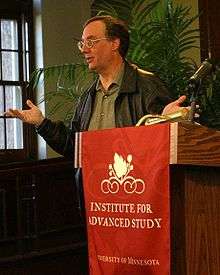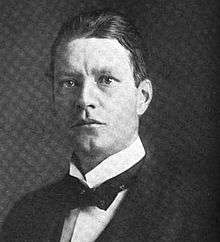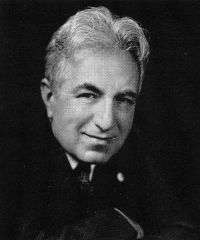List of former Bahá'ís
Ex-Bahá'ís or former Bahá'ís are people who have been members of the Bahá'í Faith for some part of their lives, but left the Bahá'í Faith for another religion or a nonreligious philosophy. The following is a list of notable ex-Bahá'ís. Many of them are viewed as violating the Covenant of Bahá'u'lláh, ensuring a united community and are thus termed Covenant-breakers, while others are viewed as not understanding the religion enough to be called members of the religion, or who changed their religion through their own beliefs.
Converted to an Abrahamic religion
Converted to Christianity
- John Ford Coley[1] - an American singer, classically trained pianist, guitarist, actor, and author most known for his partnership in the musical duo England Dan & John Ford Coley.
Converted to Islam
- Abd al-Hosayn Ayati (Avarih)[2] - Born in Yazd, Iran, in 1871, he served as a Bahá'í missionary, journalist, author and teacher, earning the title "Chief of Missionaries". He spent 18 years as a Bahá'í and became a Muslim in 1921.
Converted to Unitarian Universalism
- Juan Cole[3] - Having converted to the Bahá'í Faith in 1972, Juan Cole resigned in 1996 declaring himself a Unitarian Universalist. Cole created "H-Bahai", a website making available a wealth of difficult-to-obtain primary sources on the religion.[4]
Apostates claiming an undetermined belief system
- Abbas Amanat - Professor of History & International Studies at Yale University.[5] He received his B.A. from Tehran University in 1971 and his D.Phil. from Oxford University in 1981. He is the brother of the architect Hossein Amanat who designed the Azadi Tower in Tehran and the Universal House of Justice in Haifa.
- Denis MacEoin[3] - a Bahá'í from about 1966 to about 1980, lecturing at Bahá'í conferences and summer schools and writing in support of his religion, he departed after clashes with the Bahá'í administration.
- Ehsan Yarshater - Although born into a Bahá'í family, he has had no affiliation with the religion as an adult,[6] and has said that he himself is not a Bahá'í.
Covenant-breakers who are not related to Bahá'u'lláh
- Lewis Stuyvesant Chanler - co-founded the New History Society in New York City. He was expelled from the Bahá'í community in 1939 along with his wife(see below) and Mírzá Aḥmad Sohráb(see below) after they refused to allow the Local Spiritual Assembly of New York oversight over the operations of the New History Society.
- Ibrahim George Kheiralla - founder of the first American Bahá'í community, `Abdu'l-Bahá gave Kheiralla the titles, "Bahá's Peter," "the Second Columbus" and "Conqueror of America."[7][8] Kheiralla sided with Mírzá Muhammad `Alí in his conflict with `Abdu'l-Bahá.
- Julia Lynch Olin - an American author who co-founded the New History Society in New York City. In 1936, she translated the French version of Seven Valleys into English. She was expelled over the same issue as her husband, Lewis Stuyvesant Chanler.
- Charles Mason Remey - a prominent Bahá'í who Shoghi Effendi appointed in 1951 a Hand of the Cause[9][10] who, in 1960, declared himself to be the successor of Shoghi Effendi.[11] Remey and his followers were declared Covenant-breakers by the Hands and would subsequently be known as the almost extinct Orthodox Bahá'ís.
- Mírzá Aḥmad Sohráb[12] - co-founded the New History Society and the Caravan of East and West in New York and expelled with Lewis and Julia as above.
- Ruth White - expelled from the religion because she claimed that the will of `Abdu'l-Bahá was a forgery.[13][14]
Covenant-breakers who are part of Bahá'u'lláh's family
- Mírzá Muhammad `Alí - one of the sons of Bahá'u'lláh, known as Ghusn-i-Akbar, meaning "Greater Branch".[15] Because of provisions of the will of `Abdu'l-Bahá Shoghi Effendi labeled Ghusn-i-Akbar as the arch-breaker of the Covenant of Bahá'u'lláh.[16]
- Shua Ullah Behai - Bahá'u'lláh's eldest grandson, he led the Unitarian Baha'i denomination in the United States.
- Fatimih Khanum - Bahá'u'lláh's second wife, known as Mahd-i-'Ulya.[17] She seems to have been widowed from her first husband, perhaps aged sixteen.[18] She died in 1904, and was later labelled a Covenant-breaker by `Abdu'l-Bahá.[19]
- Samadiyyih - One of Mahd-i-'Ulya's children,[20][21] she was eventually declared a Covenant-breaker by `Abdu'l-Bahá.[20][21]
- Díyá'u'lláh - One of Mahd-i-'Ulya's children,[22][23] and was labeled a Covenant-breaker.[24][25]
- Gawhar - Bahá'u'lláh's third wife,[26] some time around 1862,[17] and remained in Baghdad,[17] until in late 1870.[27] Gawhar may have been a maid of the first wife of Bahá'u'lláh when he married her.[28] She was declared a Covenant-breaker after Bahá'u'lláh's death.[20]
- Furughiyyih - Gawhar's daughter by Bahá'u'lláh.[24] she was a labelled Covenant-breaker.[20]
- Ruhi Afnan - Ruhi Afnan was declared a Covenant-breaker by Shoghi Effendi.[29][30]
- Munib Shahid - Munib Shahid married "…according to the Moslem rites the daughter of a political exile …"[31] and was expelled.
- Husayn Ali - Husayn Ali was expelled in April 1945 by Shoghi Effendi "…after long period of dishonourable conduct, has abandoned the Master's home to consort with his sister and other Covenant-breakers…".[32]
- Riaz - Riaz was family as well and similarly expelled as a Covenant-breaker.[33]
- Mehrangiz - Mehrangiz was expelled as a Covenant-breaker after disobeying `Abdu'l-Bahá's will.[29]
See also
Notes
- ↑ Bruce, Billy (August 31, 2000). "Born-Again Rock Stars". Charisma Magazine. Retrieved September 16, 2016.
- ↑ Afshar, Iraj (August 18, 2011). "ĀYATĪ, ʿABD-AL-ḤOSAYN". Encyclopædia Iranica.
- 1 2 Momen, Moojan (2007). "Marginality and Apostasy in the Bahá'í Community". Religion. 37 (3): 187–2009. doi:10.1016/j.religion.2007.06.008. Retrieved May 8, 2016.
- ↑ "H-Bahai Website". H-net.org. Retrieved May 8, 2016.
- ↑ "Abbas Amanat". Yale University. Retrieved June 5, 2016.
- ↑ Ashraf, Ahmad (2007-04-05). "Official response of the Encyclopaedia Iranica to the Associated Press article of March 25, 2007 entitled "U.S.-funded encyclopedia revels in Iran's greatness"" (PDF). Encyclopedia Iranica. Archived from the original on 2013-04-02.
- ↑ Browne, Edward G. (1918). Materials for the study of the Bábí religion. Cambridge, UK: Digitally Reprinted. H-Bahai: East Lansing, Michigan, 2002. p. 115-137.
- ↑ Balyuzi, H.M. (2001). `Abdu'l-Bahá: The Centre of the Covenant of Bahá'u'lláh (Paperback ed.). Oxford, UK: George Ronald. ISBN 0-85398-043-8.
- ↑ Smith 1999, p. 292
- ↑ Effendi 1999, pp. 18–20
- ↑ Remey 1960, p. 8
- ↑ Sohrab, Mirza Ahmad (1959). My Bahai Pilgrimage. Autobiography from Childhood to Middle Age. New York: New History Foundation.
- ↑ White, Ruth (1946). Abdul Baha's Questioned Will and Testament. Beverly Hills, California, USA: J.J. Little and Ives Company.
- ↑ White, Ruth (1929). Is the Bahai Organization the Enemy of the Bahai Religion?. New York City, USA: J.J. Little and Ives Company.
- ↑ Taherzadeh 2000, p. 256
- ↑ Adamson 2009, p. 121
- 1 2 3 Smith 2008, p. 16
- ↑ Ma'ani 2008, pp. 230–2
- ↑ Taherzadeh 2000, p. 117
- 1 2 3 4 Taherzadeh 2000, p. 25
- 1 2 Taherzadeh 2000, p. 144
- ↑ Smith 2000, pp. 261–262
- ↑ Balyuzi 2001, pp. 222
- 1 2 Taherzadeh 2000, p. 145
- ↑ Balyuzi 2001, p. 528
- ↑ Ma'ani 2008, p. 252
- ↑ Ma'ani 2008, p. 253
- ↑ Cole, Juan. "A Brief Biography of Bahá'u'lláh". Archived from the original on 9 September 2006. Retrieved May 11, 2016.
- 1 2 Effendi, Shoghi (December 1981). The unfolding destiny of the British Baha'i community: Messages from the Guardian of the Baha'i Faith to the Baha'is of the British Isles. UK Bahá’í Publishing Trust. p. 149. ISBN 978-0900125430.
- ↑ Effendi, Shoghi (1980). Citadel of Faith: Messages to America, 1947-1957. Wilmette, Illinois, USA: Bahá'í Publishing Trust. p. 87. ISBN 978-1508530596.
- ↑ "Messages from the Guardian". Bahá'í News (172). December 1944. Retrieved May 8, 2016.
- ↑ "Messages from the Guardian" (PDF). Bahá'í News (174). April 1945. Retrieved May 8, 2016.
- ↑ Effendi, Shoghi (1999). Messages to the Bahá’í World: 1950–1957. Baha'i Publishing Trust. p. 16. ISBN 978-0877432500.
References
- Adamson, Hugh C. (2009). The A to Z of the Baha'i Faith. Rowman & Littlefield. ISBN 0810868539.
- Bacquet, Karen (2001). "Enemies Within: Conflict and Control in the Baha'i Community". Cultic Studies Journal. 18: 94–112. Retrieved May 7, 2016.
- Balyuzi, Hasan M. (2001). `Abdu'l-Bahá: The Centre of the Covenant of Bahá'u'lláh (Paperback ed.). Oxford, UK: George Ronald. ISBN 0-85398-043-8.
- Bowen, Patrick D. (August 27, 2015). A History of Conversion to Islam in the United States, Volume 1: White American Muslims before 1975. Brill. ISBN 978-9004300699.
- Bruce, Billy (August 31, 2000). "Born-Again Rock Stars". Charisma Magazine. Retrieved September 16, 2016.
- Cohen, Patricia (August 13, 2011). "A Lifetime Quest to Finish a Monumental Encyclopedia of Iran". The New York Times. Retrieved May 7, 2016.
- Cole, Juan (June 1998). "The Baha'i Faith in America as Panopticon, 1963-1997". The Journal for the Scientific Study of Religion. 37 (2): 234–238. doi:10.2307/1387523. Retrieved May 7, 2016.
- Effendi, Shoghi (December 1981). The unfolding destiny of the British Baha'i community: Messages from the Guardian of the Baha'i Faith to the Baha'is of the British Isles. UK Bahá’í Publishing Trust. ISBN 978-0900125430.
- Ficicchia, Francesco (January 1, 1981). Der Bahā'ismus-Religion der Zukunft? Geschichte, Lehreund Organisation in kritischer Anfrage. Quell. ISBN 978-3791860091.
- Glaysher, Fredrick. "The Baha'i Faith & Religious Freedom of Conscience". Retrieved May 8, 2016.
- Glaysher, Frederick. "The American Bahai Mixture". The Baha'i Faith & Religious Freedom of Conscience. Retrieved May 7, 2016.
- Ma'ani, Baharieh Rouhani (2008). Leaves of the Twin Divine Trees. Oxford, UK: George Ronald. ISBN 0-85398-533-2.
- McGinn, Sen. "Sen McGlinn's Blog Reflections on the Bahai teachings". Retrieved May 8, 2016.
- McGinn, Sen (July 15, 2012). "Requesting re-enrolment". Retrieved May 7, 2016.
- Schory, Noemi (2007). Bahais in My Backyard, A Belfilms Production (in Hebrew and English). Israel: First Hand Films. Retrieved May 8, 2016.
- Schory, Noemi (April 17, 2010). "Producer's Statement". Bahais in My Backyard, A Belfilms Production. First Hand Films. Retrieved May 9, 2016.
- Smith, Peter (1999), A Concise Encyclopedia of the Bahá'í Faith, Oxford, UK: Oneworld Publications, ISBN 1-85168-184-1
- Smith, Peter (2008), An Introduction to the Baha'i Faith, Cambridge: Cambridge University Press, ISBN 0-521-86251-5
- Stockman, Robert (2006), "The Baha'is of the United States", in Gallagher, Eugene V.; Ashcraft, W. Michael, Introduction to New and Alternative Religions in America, Greenwood Press, ISBN 0-275-98712-4
- Taherzadeh, Adib (2000). The Child of the Covenant. Oxford, UK: George Ronald. ISBN 0-85398-439-5.
- Warburg, Margit. Bahá'í: Studies in Contemporary Religion. Signature Books. p. 64. ISBN 1-56085-169-4.
- "Faithless Brother". Bahá'í News (229). March 1950. Retrieved May 8, 2016.
- "Hussein" (PDF). Bahá'í News (236). October 1950. Retrieved May 8, 2016.
- "H-Bahai Website". H-net.org. Retrieved May 8, 2016.
This article is issued from Wikipedia - version of the 11/22/2016. The text is available under the Creative Commons Attribution/Share Alike but additional terms may apply for the media files.





